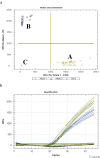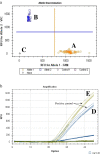Detection of clade types (clades I and II) within Anopheles funestus sensu stricto by the hydrolysis probe analysis (TaqMan assay)
- PMID: 23758959
- PMCID: PMC3691741
- DOI: 10.1186/1756-3305-6-173
Detection of clade types (clades I and II) within Anopheles funestus sensu stricto by the hydrolysis probe analysis (TaqMan assay)
Abstract
Background: Recent studies presented two clades (clades I and II) within the major malaria vector, Anopheles funestus s.s. on the mitochondrial DNA. We describe a hydrolysis probe analysis (TaqMan assay) method for the rapid identification of these two clades.
Findings: A total of 53 An. funestus s.s. from Malawi and Mozambique were tested for detection of clade types using the hydrolysis probe analysis. Results were compared to DNA sequence analysis to verify the accuracy of the probes TaqMan assay for this vector species. Analysis using the hydrolysis probe revealed that there were 21 individuals from Malawi and 13 individuals from Mozambique for clade I, and 19 individuals from Mozambique for clade II. The results were consistent with the results of DNA sequences. A field sample from northern Zambia revealed the presence of both clade types.
Conclusion: A diagnostic method using the hydrolysis probe analysis was developed to identify clade types within An. funestus s.s. This assay will be useful for screening clade types of field-collected An. funestus specimens accurately and efficiently in malaria vector research and control studies.
Figures



References
-
- Gillies MT, de Meillon B. The Anophelinae of Africa South of the Sahara. Johannesburg, South: Publications of the South African Institute for Medical Research; 1968.
-
- Gillies MT, Coetzee M. A Supplement to the Anophelinae of Africa South of the Sahara (Afrotropical Region) Johannesburg, South Africa: Publications of the South African Institute for Medical Research; 1987.
-
- Couhet A, Simard F, Toto J-C, Kengne P, Coetzee M, Fontenille D. Species identification within the Anopheles funestus group of malaria vectors in Cameroon and evidence for a new species. Am J Trop Med Hyg. 2003;69:200–205. - PubMed
-
- Harbach RE. The classification of genus Anopheles (Diptera: Culicidae): a working hypothesis of phylogenetic relationships. Bull Entomol Res. 2004;94:537–553. - PubMed
-
- Spillings BL, Brooke BD, Koekemoer LL, Chiphwanya J, Coetzee M, Hunt RH. A new species concealed by Anopheles funestus Giles, a major malaria vector in Africa. Am J Trop Med Hyg. 2009;81:510–515. - PubMed
Publication types
MeSH terms
Substances
LinkOut - more resources
Full Text Sources
Other Literature Sources

